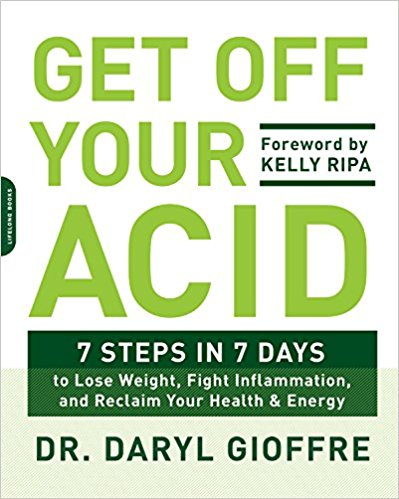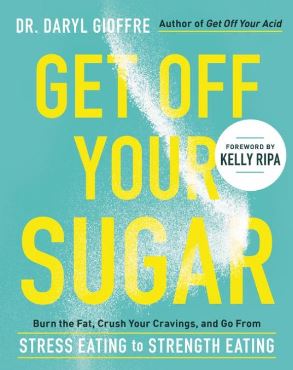 This is another post in our month-long series clearing up the confusion that I get asked about nearly every day.
This is another post in our month-long series clearing up the confusion that I get asked about nearly every day.
I can’t count the number of people who have said to me lately…
- What do you think of the Ketogenic Diet?
- “Isn’t the Alkaline Diet kind of like the Ketogenic Diet everyone’s talking about?”
- “You must like the Keto Diet because it has a lot of Alkaline foods, right, Dr. D?”
- “If I just follow the rules of Keto, will I be Alkaline too?”
This Diet has become hugely popular in the past year, and for several good reasons.
So today, I want to clarify what the Keto Diet is, how it’s similar to the Alkaline lifestyle, how it’s different, and ultimately, what I recommend for people who are interested in going Keto.
Basics of the Keto Diet
The idea behind the Ketogenic Diet is that you eat lots of healthy fats instead of carbohydrates and sugar, so you will move AWAY from burning sugar as your primary source of fuel, and in place, start to burn body fat for fuel.
That’s where the name comes from – your body enters a state of Ketosis (IF you’re doing the diet correctly), or fat-burning mode, once you’ve starved it of the carbs that are the staple of the Standard America Diet (Read: SAD).
I talk in my book, Get Off Your Acid, about how fats are a very clean source of energy, and the ideal and preferred source of fuel for your body. It’s kind of like switching from dirty coal (in this case, sugar) to clean hydroelectric power (for example, an avocado). It leaves a lot less junk behind.
So what does this mean in terms of what you can and cannot eat? You cut all:
- Refined carbs
- Sugars
- Grains
- Fruits that are high in sugar
- Potatoes
- Processed foods

Instead you eat a Diet of:
- Nuts
- Fish
- Meat
- Veggies
- Seeds
- High-fat dairy products
- Low-sugar fruits, especially avocados
- Oils like coconut and olive oil
One of the major parts of the Keto philosophy is that when you eat anything, fat should be a part of the meal.
Keto and Alkaline Overlaps
As you might have noticed, the Alkaline lifestyle does have a lot in common with what I outlined above. Certainly not everything, and we’ll get to that.
Overall, both are more lifestyles than Diets, although it’s easy to lose weight on either one. But unlike true Diets like Whole30, Mediterranean, or Paleo, Keto and Alkaline are MEANT to be maintained long term.
Plus, it’s fantastic that both lifestyle shifts cut out sugar and refined carbs in favor of real, natural whole food. No ingredient makes us sicker or fatter than sugar, and yet it’s in so many of the foods most people eat.
Last but not least, Keto and Alkaline both encourage people to eat fats along with complex carbohydrates like veggies and low-sugar fruits. That’s a great way to burn body fat as fuel and stave off candida (yeast), the opportunistic parasite that’s trying to take over your gut.
Where Keto Gets It Wrong
The Ketogenic Diet is acidic! In fact, it’s highly acidic, and I’ll tell you why.
Keto gurus urge followers to eat a ton of animal products – eggs, cheese, dairy, bacon, meat, and so on.
Because you’re eating so much animal protein and high-fat dairy, you’re not getting enough minerals from fruits and vegetables, which should be the basis for a nutritious diet.
The average American already eats 5 times too much animal protein, according to USDA recommendations. So imagine how many times the recommended daily allowance you would be eating if protein was the whole basis of your diet!

And here’s why that’s bad. First and foremost, animal proteins contain the trifecta of ACID – sulfuric, phosphoric, and nitric acids. These acids are highly inflammatory and require a LOT of energy and enzymes for your gut to break them down.
Next, once your protein intake exceeds 15% of your daily caloric intake, guess what happens? It turns to SUGAR via the liver pathway. And as sugar levels spike, so does insulin, which I call the traffic cop for ALL other hormones.
Insulin is your fat-storing hormone, and will jump-start an inflammatory cascade in your body. In addition, there is a hormonal knock-on effect. With chronic over-indulgence in animal protein, your two main satiety hormones, leptin and ghrelin, become resistant.
Therefore, your brain is never signaled, so you’re ALWAYS hungry and NEVER full!
You will be more prone to munch on empty carbs and sugar, and so the viscous cycle goes.
Not only that, but what you’re consuming with all of those animal products is downright scary.
Eggs (and chicken) are the MOST inflammatory meat, having the highest levels of arachidonic acid, which are a type of Omega-6 fatty acids. Most people consume far too many of these and not nearly enough Omega-3, and that imbalance leads to widespread inflammation.
Dairy products are filled with sugar and casein, a protein that is linked to certain cancers in humans. Cow’s milk in particular has 20 times more casein than human milk and is poorly digested to the point of damaging the human immune system. Not to mention it is filled with the sugar LACTOSE, which gets converted to LACTIC ACID in your body, another highly inflammatory acid. If that wasn’t enough for all you dairy lovers out there, milk and all dairy products has a 10:1 ratio of calcium to magnesium. In order for your body to be able to absorb the calcium in milk, it needs to be a ratio of 1:1, OR 2:1 in favor of magnesium.
So what’s the result? Your body requires more INTERNAL calcium from the bones to neutralize the acidic potential of the milk.
Here is my dairy take-home message…DAIRY IS SCARY! Despite what your doctors have led you to believe, because of the high lactose content, phosphorous content, and the heavily imbalanced 10:1 ratio of calcium to magnesium milk, doesn’t provide calcium to your bones, but rather DRAINS calcium from your bones!
Going back to the issue of inflammation, most dairy products are made of milk from cows that feed on grains and are loaded with pro-inflammatory omega-6 fatty acids, acidic hormones, and pesticide residues.
I don’t recommend dairy for anyone, especially our growing children. We are the ONLY mammals to consume another mammal’s breast milk after weaning.
Mature cows don’t even drink cow’s milk!
The question about dairy products to ask yourself is… Why do we consume milk intended for infant cows when we would never consume milk for human infants beyond toddlerhood? Dairy is anything but natural.
Why Acid Is a Problem On Keto
All of that acid from animal fats and proteins adds up. A 2017 study from the Journal of Physiology of elite race walkers found that those who followed a Ketogenic Diet needed more oxygen during their races and their performance suffered.
Why? When you exercise with more acid in your body, the workout becomes more difficult. This is the case for running, cycling, or any physical activity where lactic acid can builds up.
In this case, it’s the Keto Diet that produces too much acid, triggering a state of chronic, low-grade acidosis.
Ketosis + acidosis ≠ a happy, healthy body!
Beyond that, there is a huge misunderstanding of how to use Ketosis. Your goal is NOT to be in full Ketosis 100% of the time. This can cause health problems over the long-term. Getting a firm understanding of how to go in and out of a Ketotic state in terms of how you’re eating is a very complicated undertaking. I can’t recommend that to an average person who is not under the consultation of a health expert.
But on the flipside, if you do it correctly, and achieve the state where your body is making Ketone Bodies for energy, you will burn fat, gain energy, and destroy cancer cells.
How Can You Take Advantage of All the Good Parts of Keto Without the Bad? 
Go Alkaline! And not just Alkaline, but Alkamind! In fact, the Alkamind lifestyle is really a blend of the Alkaline Diet and the Ketogenic Diet, with a focus on vegetables and low sugar fruits with the added benefits of plenty of Alkaline fats.
What separates the Alkamind Diet from a typical Alkaline Diet (and Ketogenic Diet) is that it’s a complimentary, conscious blend of Alkaline and Ketogenic where you’re eating plenty of healthy fats, dark green leafy vegetables, cruciferous, and sulfur-based vegetables (equal a combined 80%), moderate protein (15%), and few vegetable carbs like sweet potatoes and squash (5%).
Your goal should be to eat 3 meals a day, and try to avoid snacking and grazing as these two will spike insulin levels. Aim to have 7-10 daily servings of fresh vegetables, as well as 7-10 servings of HEALTHY FATS.
There are fats that HEAL, and fats that KILL. In my new book, Get Off Your Acid, I provide an awesome chart displaying what both look like.
That said, if you eat a Keto Diet, you could maintain the 80/20 Alkaline lifestyle, where you eat 80% Alkaline and 20% acidic. Most of the foods you eat will be Alkaline, with the 20% acidic coming from meat and dairy, although preferably meat because dairy is scary. If you are going to eat meat, which some people may biologically need, remember these 2 rules:
- Keep it clean (as in organic and grass fed as this has 40x less inflammatory fats compared to conventional meat fed with corn and soy).
- Make your protein the sideshow, not the main event.
That’s why the MOST powerful and effective lifestyle you can find is the Alkamind lifestyle.
With the Alkamind lifestyle, you can reach the Ketogenic state, and replenish your body and cells with the most important nutrients at the same time: minerals and chlorophyll.
My best-selling book, Get Off Your Acid: 7 Steps in 7 Days to Lose Weight, Fight Inflammation, and Reclaim Your Health and Energy, is full of recipes, tips, and ideas to take you from sluggish and in pain to healthy, energetic, and slim.
I have an entire chapter dedicated to “How to Become a Fat-Burning Machine”, where I take a deep dive in regards to the right fats to eat, how to balance your diet, and how to achieve a state of ketosis without worrying about measuring with ketostix or breath acetone levels.
Head over to Amazon now to get your copy! Here is what Kelly Ripa (who wrote the foreword of the book) had to say about it:

“Whether your goal is to lose weight, sleep better, or boost your energy levels, this plan will get you there!”
-Kelly Ripa, from Foreword of Get Off Your Acid: 7 Steps in 7 Days to Lose Weight, Fight Inflammation, and Reclaim Your Health and Energy
 Skip to content
Skip to content








